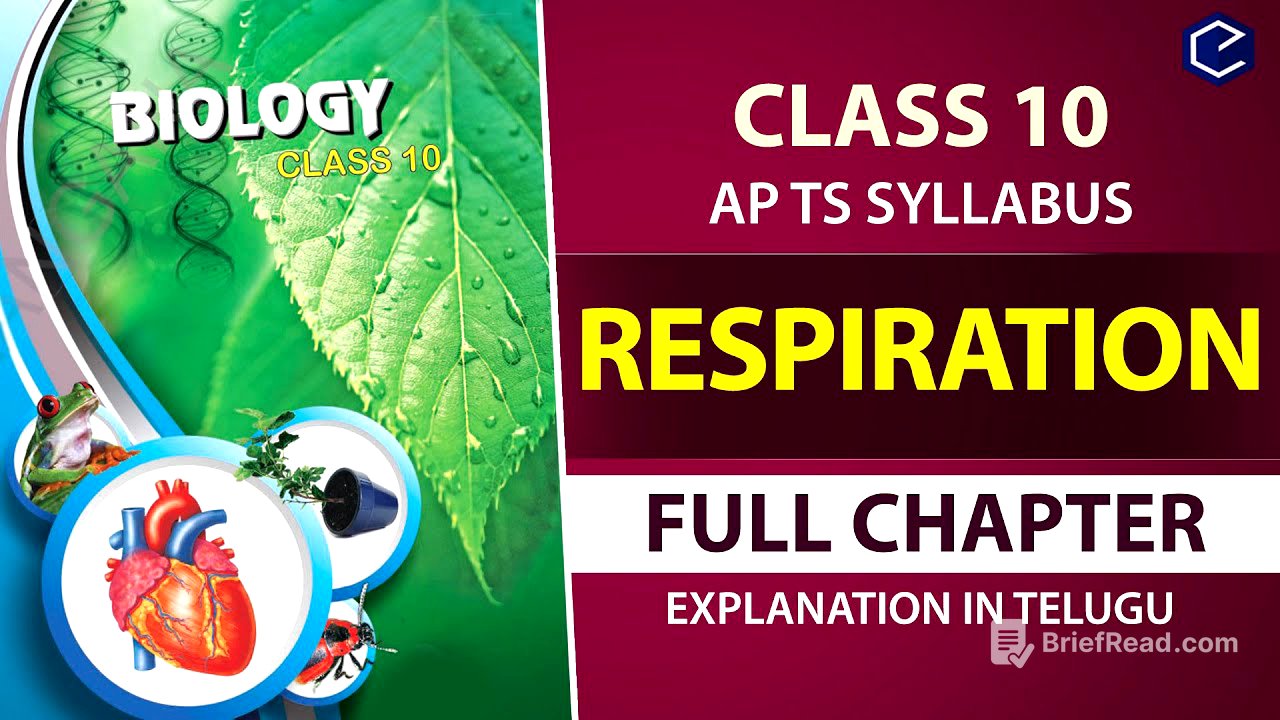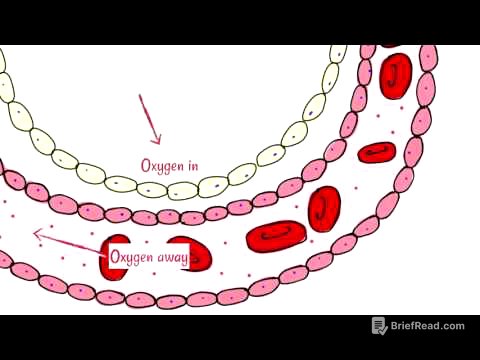TLDR;
This video provides a comprehensive overview of respiration, covering everything from the basic definition to the differences between photosynthesis and respiration in plants. It explains the process of respiration in humans, including the role of the lungs, diaphragm, and blood in transporting gases. The video also covers cellular respiration, types of respiration (aerobic and anaerobic), and the evolution of gas exchange systems in animals.
- Respiration is the process of oxidising food to produce energy.
- Exhaled air contains more carbon dioxide and water vapour than inhaled air.
- The epiglottis prevents food from entering the windpipe.
- Gaseous exchange occurs in the alveoli of the lungs.
- Photosynthesis and respiration are different processes with opposite functions.
Introduction [0:00]
The video begins by addressing the fundamental question of why we need oxygen. It explains that oxygen is essential for oxidising food, specifically glucose, within our cells. This oxidation process generates the energy required for our daily activities. The video then transitions into defining respiration and outlining the key steps involved in the process.
What is Respiration? [1:04]
Respiration is presented as a multi-step process. These steps include breathing, the exchange of gases between the lungs and blood, the transport of oxygen from the lungs to the body's tissues, the exchange of gases between the blood and cells, and finally, cellular respiration, which is the utilisation of oxygen at the cellular level.
What Does the Exhaled Air Consists Of? [3:20]
The composition of exhaled air is explored, contrasting it with inhaled air. The presenter sets up an experiment using lime water to demonstrate the differences between normal air and exhaled air.
Experiment Number 1 [3:48]
An experiment is conducted using lime water to compare the properties of inhaled and exhaled air. Normal air is pumped into a test tube containing lime water, and the colour of the lime water remains unchanged. The experiment is repeated, but this time exhaled air is used. The exhaled air turns the lime water milky, indicating the presence of a gas that is more abundant in exhaled air than in normal air. This gas is identified as carbon dioxide. The experiment also explores the presence of water vapour in exhaled air. It is explained that the water vapour comes from the fluid lining the surfaces of the airways, which evaporates and is carried away during exhalation.
The Pathway of Air From Nostrils to Alveoli [8:43]
The journey of air from the nostrils to the alveoli is detailed. Air enters through the nostrils, passes through the nasal cavity where it is humidified, and then proceeds to the pharynx, a common passage for both food and air. From the pharynx, air moves to the larynx, a stiff box containing vocal cords, and then to the trachea, a long tube supported by C-shaped cartilaginous rings. The trachea branches into bronchi, which further divide into bronchioles, ultimately leading to the alveoli, the tiny air sacs where gas exchange occurs.
Epiglottis and Passage of Air [16:05]
The role of the epiglottis in directing air and food is explained. The epiglottis is a flap-like valve that partly closes the windpipe during swallowing, preventing food from entering the respiratory system and directing it down into the stomach. The movements of the epiglottis are controlled by the nervous system. The video explains why it is not advisable to talk while eating, as attempting to talk while swallowing can cause the epiglottis to open the windpipe, potentially leading to choking.
Mechanism of Respiration in Human Beings [20:18]
The mechanism of respiration in humans is discussed, emphasising that the lungs cannot operate on their own. The lungs are aided by other organs, including the rib cage and the diaphragm. The rib cage expands and contracts to change the volume of the chest cavity, while the diaphragm, a flexible flattened muscle located below the lungs, plays a crucial role in inhalation and exhalation.
Role of Diaphragm in Respiration [24:36]
The function of the diaphragm during breathing is further explained. During inhalation, the diaphragm contracts and flattens, increasing the volume of the chest cavity and allowing air to flow into the lungs. During exhalation, the diaphragm relaxes and returns to its dome shape, decreasing the volume of the chest cavity and forcing air out of the lungs.
Gaseous Exchange Between Lungs and Blood [26:04]
The process of gaseous exchange between the lungs and blood is detailed. The lungs are composed of tiny, sac-like structures called alveoli, which are surrounded by a network of blood capillaries. The walls of the alveoli and blood capillaries are very thin, only one cell thick, which facilitates the easy diffusion of gases. Oxygen diffuses from the alveoli into the blood, while carbon dioxide diffuses from the blood into the alveoli.
Transportation of Gases in Blood [30:41]
The video explains how oxygen and carbon dioxide are transported in the blood. Oxygen binds to haemoglobin, a protein found in red blood cells, forming oxyhaemoglobin. Carbon dioxide is transported in three ways: as bicarbonate, bound to haemoglobin, and dissolved in plasma.
Gaseous Exchange Between Blood & Tissues [33:50]
The exchange of gases between the blood capillaries and the cells of the body's tissues is described. Oxygen, carried by haemoglobin, separates from the haemoglobin and diffuses from the blood into the cells. Carbon dioxide, a waste product of cellular activity, diffuses from the cells into the blood.
Cellular Respiration [39:10]
Cellular respiration is defined as the process by which energy is released from food molecules within the cells. This process consumes oxygen and produces energy, carbon dioxide, and water. The energy stored in the chemical bonds of food molecules is released during cellular respiration, providing the energy needed for life processes.
Types of Respiration [40:32]
The two main types of respiration, aerobic and anaerobic, are compared. Aerobic respiration occurs in the presence of oxygen and is the primary mode of respiration in eukaryotic organisms, including humans. Anaerobic respiration occurs in the absence of oxygen and is common in prokaryotic organisms, such as bacteria and yeast. Aerobic respiration produces more energy than anaerobic respiration.
Cellular Respiration (ATP) [48:15]
The role of ATP (adenosine triphosphate) as the energy currency of the cell is explained. ATP is produced during cellular respiration and provides the energy needed for various cellular processes. The process of ATP production and energy transfer within the cells is described.
Production of Energy Without Oxygen [51:26]
The video discusses how energy can be produced without oxygen through anaerobic respiration or fermentation. This process is less efficient than aerobic respiration and produces less energy.
Fermentin Sugar in Lab [56:00]
An experiment is described in which sugar is fermented in a lab setting. After a few hours, the liquid develops a foul smell, which is the smell of alcohol, indicating that fermentation has taken place.
Respiration & Combustion [58:21]
The similarities and differences between respiration and combustion are explored. Both processes involve the release of energy and the production of carbon dioxide and water. However, combustion requires external heat to start, takes place at high temperatures, and releases energy rapidly, while respiration occurs inside cells at normal body temperature and releases energy slowly and gradually.
Evolution of Gases Exchange Systems in Animals [1:04:28]
The evolution of gas exchange systems in animals is discussed. Different animals have evolved different mechanisms for gas exchange, including diffusion through the body surface, exchange of gases by moist skin (cutaneous respiration), tracheal respiration, respiration by gills (branchial respiration), and respiration by lungs.
Respiration in Plants [1:11:34]
Respiration in plants is explained, noting that plants, like animals, need to respire to produce energy. Plants exchange gases through stomata, lenticels, and their general surface.
Photosynthesis VS Respiration [1:15:32]
The video concludes by comparing and contrasting photosynthesis and respiration. Photosynthesis takes place in green plants and some bacteria, while respiration takes place in all living organisms. Photosynthesis produces oxygen and utilises carbon dioxide, while respiration consumes oxygen and produces carbon dioxide. Photosynthesis takes place only in green cells of plants, while respiration takes place in all cells. Photosynthesis is dependent on light, while respiration is not.









